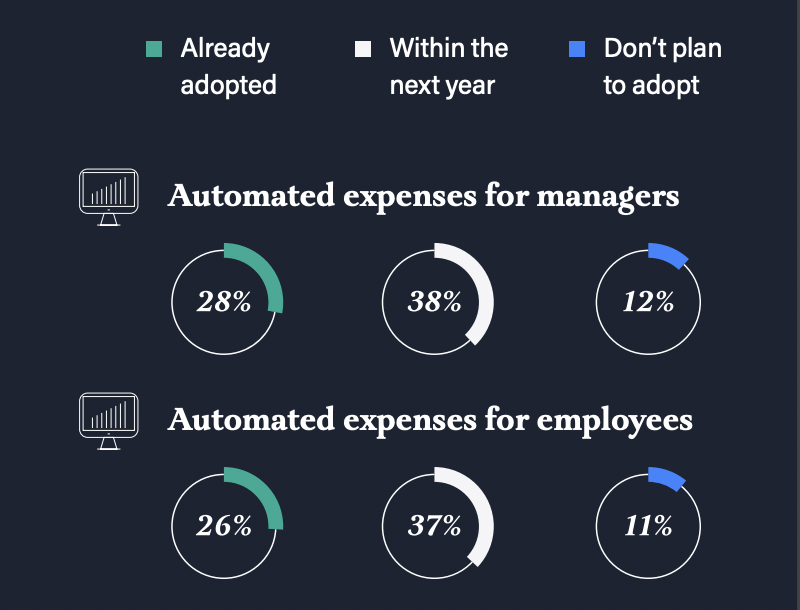Automation Is Now the Foundation of Corporate Travel and Expense Management, Expense Reporting, and Payment

How to Kickoff Corporate Expense Automation?
Companies often like the sound of automation, but need guidance into how to best deploy it at their organization. Financial decision-makers are understandably hesitant to make changes if things are working, or shy about trying anything new if it’s not proven.
The good news is that there are a lot of low-risk travel & expense automations that can have a big impact.
First define what the ROI of such a project would be, for example in monthly hours recouped. Then work with accounting and finance to prioritize which small projects are achievable within a pilot period.
After successfully launching small automations, and tracking/achieving ROI, there will be more appetite for larger projects.
>> Related: Anatomy of the New Corporate Travel Tech Stack <<
What are Examples of Automation in Corporate Travel, Payment, and Expense Software?
Companies can automate the most manual and annoying parts of the corporate travel, payments, and expense processes.
Expense Management Automation
The expense process has the most to gain:
- Approved expenses can be automatically reimbursed
- Managers can automatically receive alerts for out-of-policy requests
- And expense reports can be automatically added to the general ledger
Expense management automation transforms the traditional, labor-intensive process of managing expenses into a streamlined and efficient operation. Through the use of specialized software, businesses can automatically track, verify, and reimburse expenses incurred by employees. Automated systems ensure that policies are consistently applied across all submissions, enhancing compliance with internal and external regulations. Furthermore, expense management automation provides valuable insights into spending patterns, enabling companies to identify potential savings and make informed decisions regarding budget allocations.
Expense Report Automation
Expense report automation not only reduces the workload on the employees tracking expenses but also minimizes errors associated with manual data entry and calculations. Employees benefit from a simplified submission process, improving overall satisfaction and productivity. The integration of mobile technology allows receipts and expenses to be uploaded on-the-go, offering convenience and flexibility for a mobile workforce. This modern approach to expense reporting represents a significant step forward in operational efficiency and financial oversight.
Corporate Travel Automation
A corporate travel platform that integrates dynamic budgeting — or the ability to automatically adjust travel spending guidelines based on changing circumstances — can help immensely with approvals by looking at flights and hotels for a team offsite or other group travel function all together.
>> Related: How Much Does Expense Management Software Cost? <<
Travel and expense automation can handle any number of straightforward employee support and service requests. There’s no reason to have to call a human on the phone to book or change a flight if the information needed is already available in an app. And no one wants to call a customer service agent to ensure they have on-time car service at the airport when they can simply pre-order a ride on their own device, now up to 90 days in advance.
Frequently Asked Questions
What is expense automation and why is it important?
Expense automation refers to the process of using software and tools to streamline and digitize the expense management workflow. It helps organizations automate expense tracking, reporting, and approval processes, leading to increased efficiency, accuracy, and cost savings. Expense automation is crucial for modern businesses to eliminate manual tasks, reduce errors, and gain better visibility into spending.
How does expense automation software work?
Expense automation software automates the entire expense management process, from capturing receipts and expense data to approval and reimbursement. It typically involves features such as receipt scanning, automatic categorization of expenses, integration with accounting systems, and customized workflows for expense approvals.
What are the benefits of automating expense management?
Automating expense management offers numerous benefits, including increased efficiency, reduced manual errors, improved compliance with expense policies, faster reimbursement turnaround time, better control over expenses, enhanced visibility into spending patterns, and overall cost savings for the organization.
How can expense automation software help in saving time?
Expense automation software streamlines the entire expense management process, reducing the time spent on manual tasks such as data entry, expense tracking, and approval workflows. By automating these processes, employees and finance teams can save time, focus on more strategic tasks, and avoid the hassle of dealing with paper receipts and spreadsheets.
What are the key features to look for in expense management software?
When selecting expense management software, consider features such as receipt scanning, automated categorization of expenses, mobile app for on-the-go submissions, customizable approval workflows, integration with accounting systems, real-time reporting, policy compliance checks, and scalability to meet the organization’s growing needs.
How can expense automation improve expense policy compliance?
Expense automation ensures that all expense claims adhere to the organization’s expense policies by enforcing rules and limits in the software. It can flag non-compliant expenses, provide real-time policy notifications to employees, and enable managers to easily review and approve expenses that meet the specified guidelines, thereby enhancing overall compliance.




